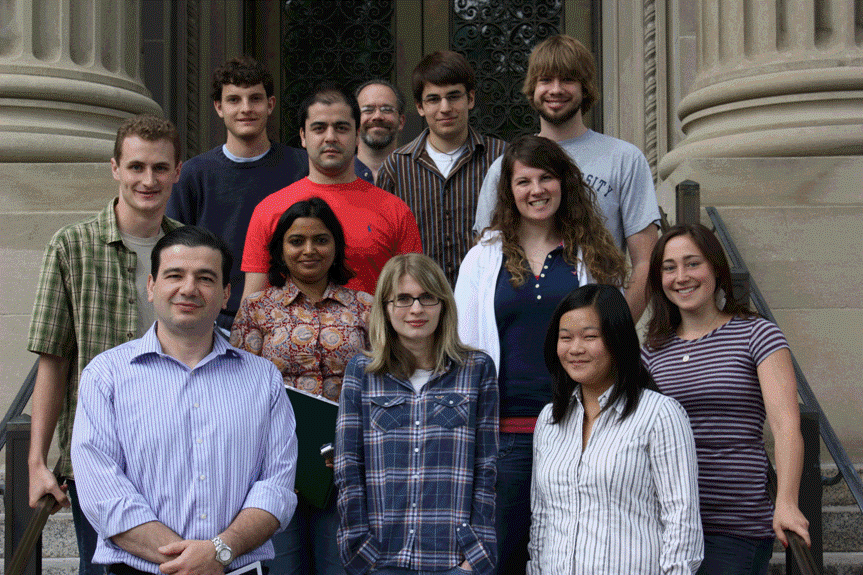Team:Minnesota
From 2009.igem.org
| Line 22: | Line 22: | ||
<h2>The Mission</h2> | <h2>The Mission</h2> | ||
| - | <p> | + | <p>We are working on a very well studied AND gate, which is composed of elements of the Tet, Lac, and lambda-phage promoters and is responsive to the commonly-used inducers IPTG and aTc, producing GFP as an output signal. |
| - | + | Well, we have decided not to ride the wave of ever-more complex synthetic constructs. Instead, we will isolate elements of the AND gate and study them individually. This will allow for a greater understanding of how exactly this AND gate works, and will eventually allow for creation of better AND gates, and a more predictable response to inputs by the biological systems.</p> | |
| - | <p>Our group will be doing both experimental and modeling work this year. These two approachs will | + | <p>Our group will be doing both experimental and modeling work this year. These two approachs will complement each other. The experimental data will be used to refine the mathematical models, while the models will determine good directions for the experiments to pursue. We will go into greater detail on both these aspects on theeir respective wiki pages. The approach we are taking can be applied to many other biological circuits and can lead to greater understanding of how to engineer biological circuits. |
| + | <p> What is unique in our work is the effort to develop software tools that streamline the construction of synthetic biological systems. The Synthetic Biology Software Suite is the product of our work, and this year iGEM students are working on SynBioSS Designer, a tool that uses Registry parts to build a model of biomolecular interaction. This model can be used to simulate the dynamic behavior of the gene network.<\p> | ||
<h2>Highlights for the Judges</h2> | <h2>Highlights for the Judges</h2> | ||
Judges! Please navigate to our [https://2009.igem.org/Team:Minnesota/Criteria Judging Criteria] page for a comprehensive list of UMN's fulfilled medal requirements and links throughout the wiki. | Judges! Please navigate to our [https://2009.igem.org/Team:Minnesota/Criteria Judging Criteria] page for a comprehensive list of UMN's fulfilled medal requirements and links throughout the wiki. | ||
Revision as of 17:08, 28 August 2009
| Home | The Team | The Project | SynBioSS Designer | Modeling | Experimental | Competition Requirements |
|---|
Welcome!
Welcome to the Team Minnesota Wiki for iGEM 2009!
We are a team of undergraduate and graduate students along with many advisors. This is the second year that Minnesota has sent a team to iGEM. Last year we were runners-up for the Best New BioBrick part (Natural) and we hope to accomplish even more with our design of a logical AND gate in E. coli this year.
The Mission
We are working on a very well studied AND gate, which is composed of elements of the Tet, Lac, and lambda-phage promoters and is responsive to the commonly-used inducers IPTG and aTc, producing GFP as an output signal. Well, we have decided not to ride the wave of ever-more complex synthetic constructs. Instead, we will isolate elements of the AND gate and study them individually. This will allow for a greater understanding of how exactly this AND gate works, and will eventually allow for creation of better AND gates, and a more predictable response to inputs by the biological systems.
Our group will be doing both experimental and modeling work this year. These two approachs will complement each other. The experimental data will be used to refine the mathematical models, while the models will determine good directions for the experiments to pursue. We will go into greater detail on both these aspects on theeir respective wiki pages. The approach we are taking can be applied to many other biological circuits and can lead to greater understanding of how to engineer biological circuits. <p> What is unique in our work is the effort to develop software tools that streamline the construction of synthetic biological systems. The Synthetic Biology Software Suite is the product of our work, and this year iGEM students are working on SynBioSS Designer, a tool that uses Registry parts to build a model of biomolecular interaction. This model can be used to simulate the dynamic behavior of the gene network.<\p>
 "
"

